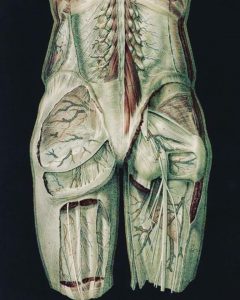Here is some of the information I recently shared in my May newsletter. Each newsletter has a specific focus. This month is focused on fascia information. If you would be interested in receiving my newsletters, please head over to my contact page and sign up.
STUDIES and ARTICLES
I receive a weekly update on anything published anywhere on the internet that includes information about fascia. I try to glean the best of the information and provide a brief synopsis of the information. If you come across any information that you think would be good to share, please also feel free to pass that information along to: info@dev.holistichealingarts.net
1. A blog article titled, Fascia as a Proprioceptive Organ and its relationship to Chronic Pain, by Dr. Russell Schierling, offers several important concepts:
2. An awesome post, found on Massage CE Directory on Facebook, regarding the Posterior pelvic fascia.

Posterior Pelvic fascia
3. A study, Attenuation of postoperative adhesions using a modeled manual therapy, published at PLOS One, concludes: Maintained movements of damaged structures in the immediate postoperative period has potential to act as an effective preventive for attenuating cohesive postoperative adhesion development.
4. An article titled, Expression of the endocannabinoid receptors in human fascial tissue, published at Fascia & Fitness, discussed a study from the Stecco group at the University of Padova in Italy published in the European Journal of Histochemistry, and confirms the presence of cannabinoids receptors in fascia.
5. A blog article, Questions to Consider for Myofascial Therapy by Whitney Lowe, points out the results of a study from 2002 that has largely been ignored: There is negligible friction between the skin and this underlying fascial tissue. This should result in several techniques being questioned.
6. A blog post, Fascia Micro Trauma may Contribute to DOMS, posted on Fascia & Fitness, proposes: increased sensitivity of muscle fascia to the stimulus (acupuncture needle) suggesting the source of pain is fascia rather than the muscle fibers themselves.
7. A peer-reviewed article, The Awareness of the Fascial System, published on Cureus, is a great overview of how fascia functions, offering “new perspectives to understand what happens during palpatory contact. A fascial cell has not only memory but also the awareness of the mechanometabolic information it feels, and it has the anticipatory predisposition in preparing itself for alteration of its natural environment.
8. An article titled, Anatomy of the Superficial Fascia System of the Breast: A Comprehensive Theory of Breast Fascial Anatomy, published in Plastic and Reconstructive Surgery Nov 2018, concludes: the breast is shaped by a three-dimensional, fibrofatty fascial system. Two layers of this system surround the corpus mammae and fuse together around it, and anchor it to the chest wall in a structure we have called the circummammary ligament.
9. An article, Fascia is Able to Actively Contract and May Thereby Influence Musculoskeletal Dynamics: A Histochemical and Mechanographic Investigation, published in Front. Physical. Apr 2019, concludes: tension of myofascial tissue is actively regulated by myofibroblasts with the potential to impact active musculoskeletal dynamics
10. A study titled, Roller Massage: Comparison of three different surface type pattern foam rollers on passive knee range of motion and pain pereption, published in Journal of Bodywork and Movement Therapies May 2019, concludes: The GRID and multilevel surface rollers produced greater immediate post-intervention effects than the smooth roller. The therapeutic effects of the GRID and multilevel rollers may be due to the surface architecture. These rollers may provide a greater deformation of the tissues which creates a local mechanical and global neurophysiological effect.